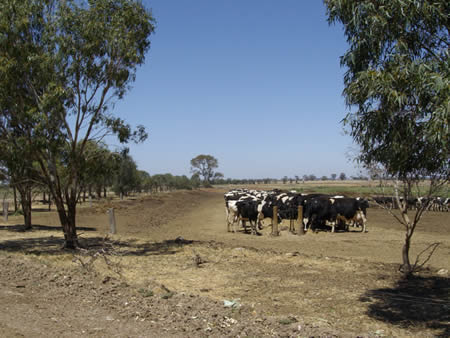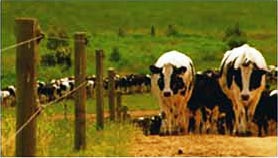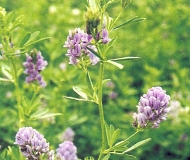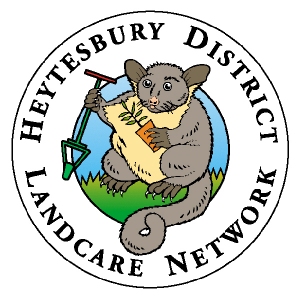Understanding the problem
|
| Why is it important to me as a farmer?
|
- Potential for wind and water erosion
- 1 mm of topsoil lost by erosion equals about 10 tonnes of soil per hectare
|
- Not making best use of summer rainfall
- Non-productive use of land
- Invasion of weeds
|
- In dry periods, soils become more susceptible to wind and water erosion as a result of
the removal of the protective vegetative soil cover
- This is caused by stock grazing and the trampling of the soil surface degrading the soil
structure
|
- Grazing stock may also cause irreparable damage to perennial pastures if the grazing
pressure is too hard. Stock, under low feed conditions will also strip a majority of the
stored annual pasture seed supply in the soil
- Loss of cover in dry times is often an issue where there is a dominance of annual plant
species over perennials
|
| How to recognise it in the paddock
|
- Bare paddocks are defined for this region by the following percentage of ground cover:
- A minimum of 70% groundcover is the accepted benchmark for the high
rainfall zone (>550mm) except for sloping country where higher than 90% ground cover is needed
|
- See photographs in Figures 1-4 below depicting groud cover percentages
|
| What is the best practice?
|
- The problems of degrading paddocks and long term decreases in productivity during
drought are considerable, however a number of strategic management options can be
put in place to minimize potential damage and give the paddock the greatest potential to
recover rapidly and fully after rain
|
- Essentially, the strategy aims to maintain a protective vegetative cover of the soil surface
or groundcover. The vegetative cover can be living plant material, failed crops, crop
stubbles or pasture residues
|
| How can you achieve this?
|
Measure groundcover - do this irrespective of whether you are operating a grazing or
cropping enterprise:
- Note that in this region, a minimum of 70% groundcover is the accepted benchmark
for the high rainfall zone except for sloping country where close to 100% is needed:
- Visualise a 50 cm by 50 cm square or make one out of wire
- For each paddock, record groundcover at about 30 random locations, look at the
variation (highest and lowest values) and calculate the average
- Look for more visual signs of erosion and soil loss such as gullies, rills and
tunnelling, washing of soil, dung and litter along fence lines and around plants,
muddy and silted dams and muddy streams with high sediment load
- Monitor groundcover and grazing activity regularly to assess progress . Use the
following photos as a guide to the amount of ground cover in your paddocks:
|
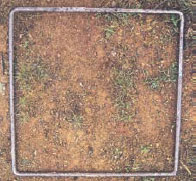
Figure 1 - 20% ground cover
|
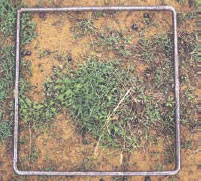
Figure 2 - 40% ground cover
|
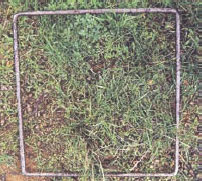
Figure 3 - 70% ground cover
|
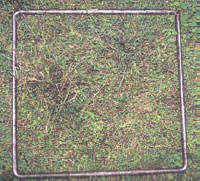
Figure 4 - 90% ground cover
|
|
Photos source: Greg Lodge, NSW DPI
|
|
|
|
1. Pastures:
Reduce grazing pressures on pastures where groundcover is below acceptable levels:
- Remove stock from paddocks once the pasture falls below the following triggers
- >70% ground cover on flat country
- < 90% ground cover on hilly country
- Or <800kg DM/ha
- Reduce stock numbers prior to summer (e.g. sell lambs)
- Use the Meat and Livestock Australia Stocking Rate Calculator
- Match the feed supply more closely to livestock
- e.g. choice of calving or lambing time which influences how well livestock
feed nutritional demands match pasture availability
- Use Evergraze pasture growth calculator
- Establish stock containment areas:
- What is a stock containment area?
- A carefully selected part of the property which is set up to hold,
feed and water core farm-stock during adverse weather periods
- It should be considered as part of the property management plan
and once established should be maintained and be available for
use during emergencies
- Benefits:
- Protection of vegetative cover on majority of property
- Less stress on flora and fauna values of the property
- Facilitation of stock feeding, watering, monitoring and handling
- Control of shelter and shade
- Better control of weed contamination associated with imported feed
|
Figure 5 - Stock Containment Area. - Source: DEPI, Victoria
- Use sacrifice areas - areas where pasture was unimproved or is planned for
improvement and can feed in these areas
- Plant lucerne or summer fodder crop or summer active species suitable to
climate and soil conditions to provide feed in summer
Figure 6 - Lucerne. - Source: DPI, NSW
Pasture responses in perennial and annual pastures after dry periods:
- Perennial pastures if managed properly through dry periods will be the first to respond following breaking rains to provide feed. If not managed properly however, the cost of repairing or resowing perennial pastures will be high
- Annual pastures may need to be resown with a subsequent lag in providing feed following breaking rain. Fertiliser rates could be reduced at sowing due to low nutrient use by previous pasture
|
2. Crops
- It is important to maintain cover on all cropping paddocks
- Crops that have failed should not be grazed due to the limited quantity of vegetative
cover they will offer the soil. Valuable nutrients will also be removed from cropping
paddocks by grazing of failed crops
- In addition, standing anchored crops or stubble provide more protection than flat crops
- Field pea and lupin crops will offer very little protection unless they remain standing and
therefore should not be grazed
- Crops that have been stripped need to have the quantity of stubble remaining assessed
to determine the extent of grazing before the risk of unacceptable damage will become
too great. This will depend upon soil type, location and whether the stubble is standing or
flat
|
- The burning of stubble should be avoided and cultivation of soils, particularly light
textured soils (sandy), should be avoided unless no cover remains
- If no soil cover remains, emergency measures such as ripping may work on heavier soils
however, ridging on lighter soils has limited success in preventing erosion
- Soils whether light or heavy have a much greater ability to resist erosive forces by wind
or water if vegetative cover remains with minimal trampling by stock
|
Other related questions in the Brown Book
|
|
Brown Book content has been based on published information listed in the Resources and References sections below
|
- Lisa Miller- pers. comm. DPI Geelong.
- Making More From Sheep. Module 6: Health Soils - Australian Wool Innovation (AWI)
and Meat and Livestock Australia (MLA).
|
- Paddock protection and stock management during dry times. Department of Primary
Industries, Victoria.
- Stock Containment Areas. Department of Primary Industries, Victoria.
|
|
